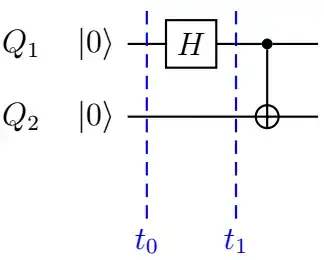I understand that starting with
we can get to $\vert \Phi^+ \rangle$. First, we start with $\vert Q_1 \rangle \otimes \vert Q_2 \rangle = \vert 0 \rangle \otimes \vert 0 \rangle$ and then applying $H$ on $Q_1$ which gives $\left( \frac{1}{\sqrt{2}}\vert 0 \rangle + \frac{1}{\sqrt{2}}\vert 1 \rangle \right)\otimes \vert 0 \rangle$. After $t_1$, we obtain $\frac{1}{\sqrt{2}}\vert 00 \rangle + \frac{1}{\sqrt{2}}\vert 10 \rangle$. Then, we apply the $CNOT$ gate to end up with $$\vert \Phi^+ \rangle = \frac{1}{\sqrt{2}}\vert 00 \rangle + \frac{1}{\sqrt{2}}\vert 11 \rangle.$$
I am wondering if there is a way to show all of this using the matrix representation of gates. I have tried the following way but I can't seem to get it properly:
We start with the state $\vert 00 \rangle = \scriptstyle\begin{bmatrix}1\\0\\0\\0\end{bmatrix}$. Between $t_0$ and $t_1$, I applied $$H \otimes I = \begin{bmatrix}\frac{1}{\sqrt{2}} & \frac{1}{\sqrt{2}} & 0 & 0\\\frac{1}{\sqrt{2}} & -\frac{1}{\sqrt{2}} & 0 & 0\\ 0 & 0 & \frac{1}{\sqrt{2}} & \frac{1}{\sqrt{2}}\\0 & 0 & \frac{1}{\sqrt{2}} & -\frac{1}{\sqrt{2}}\end{bmatrix},$$ since we are manipulating $Q_1$ and leaving $Q_2$ unchanged to obtain $\scriptstyle\begin{bmatrix}\frac{1}{\sqrt{2}}\\\frac{1}{\sqrt{2}}\\0\\0\end{bmatrix}$. Lastly, we apply $CNOT$ which gives us $\scriptstyle\begin{bmatrix}\frac{1}{\sqrt{2}}\\\frac{1}{\sqrt{2}}\\0\\0\end{bmatrix}.$
I am really looking for the matrices required to achieve the desired result.
